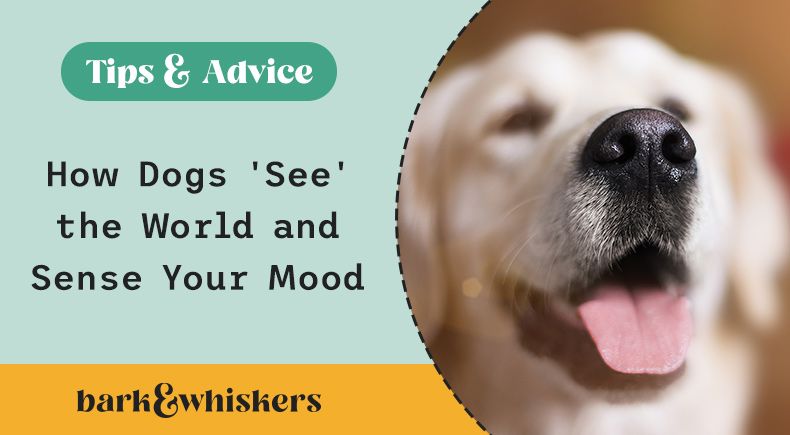How Dogs 'See' the World and Sense Your Mood
Finally, there's proof of what dog parents have suspected for a long time. Your dog can sense your mood, know when you are stressed, feel happy or frightened. But how does that affect your dog's long-term well-being? Can your emotions cause disease - and even tumors - in your dog?

STORY AT-A-GLANCE
- The results of a new study show that dogs can smell stress from human sweat and breath, putting to rest arguments against pet parents who are certain their dogs can sense their moods
- After training, the four dogs in the study quickly alerted to every stress sample presented to them using only their sense of smell, with no access to visual or audio cues
- The results confirm that trained dogs can detect, from odor alone, aspects of the physiological processes associated with conditions such as anxiety, panic attack disorders, and PTSD
- An earlier study revealed the truth of an old wives’ tale: dogs can indeed smell human fear; the study also showed that dogs who smell human fear tend to mirror the emotion and become fearful themselves
According to a new study1 from researchers at Queen's University Belfast, dogs can smell stress from human sweat and breath. This explains, at least in part, why your furry BFF often seems in tune with your emotions.
Dogs Quickly Alert to Every Stress Sample
The study involved 4 dogs from Belfast: Treo, Fingal, Soot, and Winnie, and 36 people. The (human) participants were instructed to solve a difficult math problem, before and after which the researchers collected samples of their sweat and breath. The test-takers also self-reported their stress levels before and after the task, and researchers used only samples from participants whose blood pressure and heart rate had increased.
For their part, the dogs were first taught how to search a scent line-up and alert researchers to the correct sample. Next, the stress and relaxed scent samples were introduced, but the researchers did not yet know if there was an odor difference the dogs could detect.
In every test session, the dogs were given one person's relaxed and stressed samples, collected only four minutes apart. All 4 dogs correctly alerted the researchers to each person's stress sample.

|

|

|

|
From the study: Each dog performing their alert behavior to indicate their choice on the three alternative forced choice apparatus. |
|
Once Again, the Evidence Shows the Nose Knows
According to lead study author Clara Wilson, a PhD student in the School of Psychology at Queen's:
"The findings show that we, as humans, produce different smells through our sweat and breath when we are stressed and dogs can tell this apart from our smell when relaxed — even if it is someone they do not know.
The research highlights that dogs do not need visual or audio cues to pick up on human stress. This is the first study of its kind and it provides evidence that dogs can smell stress from breath and sweat alone, which could be useful when training service dogs and therapy dogs.
It also helps to shed more light on the human-dog relationship and adds to our understanding of how dogs may interpret and interact with human psychological states."2
The study concludes:
"These results suggest that there is a VOC [volatile organic compounds, how odors are described] profile associated with acute psychological stress that is detectable by trained dogs. Having established that this odor is detectable, further investigations may wish to apply this to real-world settings."3
Examples for potential use of this research, according to the study:
"Service dogs for those with anxiety, panic attack disorders, and PTSD are growing in popularity and the results of this study confirm that trained dogs are able to detect the physiological processes associated with an aspect of these conditions from odor alone."4
Dogs Use Their Noses to 'See' the World
According to pet parent Helen Parks, owner of Treo, a two-year-old Cocker Spaniel (bottom right photo, above):
"As the owner of a dog that thrives on sniffing, we were delighted and curious to see Treo take part in the study. We couldn't wait to hear the results each week when we collected him. He was always so excited to see the researchers at Queen's and could find his own way to the laboratory.
The study made us more aware of a dog's ability to use their nose to "see" the world. We believe this study really developed Treo's ability to sense a change in emotion at home. The study reinforced for us that dogs are highly sensitive and intuitive animals and there is immense value in using what they do best — sniffing!"5
All the above makes perfect sense when you realize that unlike people, who respond most often to what they see, dogs lead with their noses and respond most often to what they smell.
Dogs Also Sniff Out Human Happiness and Fear
In a study published in 2017, a team of university researchers in Italy and Portugal set out to answer the question, "Do human body odors (chemosignals) produced under emotional conditions of happiness and fear provide information that is detectable by pet dogs (Labrador and Golden retrievers)?"6
For the study, 8 human volunteers watched a 25-minute video designed to provoke emotional states of either fear or happiness. The volunteers' sweat was collected on pads as they watched the video, and then the samples were pooled to obtain composite "fear sweat" and "happiness sweat" samples. There was also an unscented control sample.
The 40 study dogs were Labs and Goldens fitted with heart rate monitors. Each dog was placed in a small room with his owner and a stranger who had not provided a sweat sample. The two people were seated, reading magazines, and not purposely interacting with the dog.
The samples (either fear or happy sweat, or no scent) were diffused into the room from an open vial containing the sweat pads. The dogs were able to sniff the vial itself, but they couldn't directly touch the pads.
Behind the scenes, for 5-minute periods the researchers evaluated the dogs' heart rate, body language, movements toward and away from the owner and the stranger, and stress-related behaviors. The goal was to learn whether the dogs would show a consistent set of behaviors in response to the three conditions.
The Smell of Human Fear Causes Fearful Response in Dogs
The dogs exposed to the happy sweat sample had fewer and shorter interactions with their owners, and more interactions with the strangers in the room. This indicates the dogs felt relaxed enough to check out strangers and didn't need to seek reassurance from their owners.
In contrast, the dogs exposed to the fear sweat sample displayed more frequent and longer-lasting stress-related behaviors, in some cases, for the entire 5-minute period. These dogs also sought out their owners rather than the strangers, indicating they were looking for reassurance because they felt stressed.
The dogs exposed to the fear sweat sample also had consistently higher heart rates than the dogs exposed to the happy sweat sample and the control sample.
"While the dogs were clearly responding emotionally to the scent of fear," writes dog expert Stanley Coren Ph.D., "it seemed as though their response mirrored the emotion that they were detecting in that they were acting in a fearful manner themselves. There was no evidence of aggression toward either the owner, the stranger, or the scent dispensing apparatus."7
A bigger question for me, as a veterinarian, is how long-term exposure to human stress and emotional imbalances in the home (fear, anger, frustration, etc.) impact our pets' health without our knowledge.
In the dog cancer documentary I developed with Rodney Habib, almost every researcher we interviewed brought up the role of stress in canine disease, a topic that hasn't been studied extensively, but preliminarily, findings in dogs with cancer suggest it's a worthy topic to investigate.8 These studies brings up the question of how negative human emotions play into health and disease patterns in pets.
Sources and References
- 1,3,4 Wilson, C. et al. Dogs can discriminate between human baseline and psychological stress condition odors, PLoS One, September 28, 2022
- 2,5 Queen's University Belfast News, September 28, 2022
- 6 Animal Cognition 2017
- 7 Psychology Today, October 25, 2017
- 8 Cannas, S. et al. January 2016 Macedonian Veterinary Review 39(2)
Today's Pet Video:
Guy Finds the Perfect Kitten He's Been Looking For
Seeing a very friendly kitten in need of someone to take care of him, this guy can’t resist. When he starts baby-talking to the kitty, though, you know they’re for keeps!










